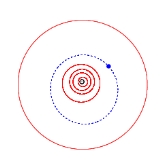
9996 ANS
Encyclopedia
9996 ANS is a C-type
main belt asteroid. It orbits the Sun
once every 4.68 years.
Discovered on October 17, 1960 by C. J. van Houten
and I. van Houten-Groeneveld on archived photographic plate
s made by T. Gehrels, it was given the provisional designation 9070 P-L. It was later renamed in honour of the Astronomical Netherlands Satellite
, an X-ray
and gamma ray
telescope located in space
.
C-type asteroid
C-type asteroids are carbonaceous asteroids. They are the most common variety, forming around 75% of known asteroids, and an even higher percentage in the outer part of the asteroid belt beyond 2.7 AU, which is dominated by this asteroid type...
main belt asteroid. It orbits the Sun
Sun
The Sun is the star at the center of the Solar System. It is almost perfectly spherical and consists of hot plasma interwoven with magnetic fields...
once every 4.68 years.
Discovered on October 17, 1960 by C. J. van Houten
Cornelis Johannes van Houten
Cornelis Johannes van Houten was a Dutch astronomer, sometimes referred to as Kees van Houten.Born in The Hague, he spent his entire career at Leiden University except for a brief period as research assistant at Yerkes Observatory...
and I. van Houten-Groeneveld on archived photographic plate
Photographic plate
Photographic plates preceded photographic film as a means of photography. A light-sensitive emulsion of silver salts was applied to a glass plate. This form of photographic material largely faded from the consumer market in the early years of the 20th century, as more convenient and less fragile...
s made by T. Gehrels, it was given the provisional designation 9070 P-L. It was later renamed in honour of the Astronomical Netherlands Satellite
Astronomical Netherlands Satellite
The Astronomical Netherlands Satellite was a space-based X-ray and ultraviolet telescope. It was launched into Earth orbit on 30 August 1974 at 14:07:39 UTC in a Scout rocket from Vandenberg Air Force Base, United States...
, an X-ray
X-ray
X-radiation is a form of electromagnetic radiation. X-rays have a wavelength in the range of 0.01 to 10 nanometers, corresponding to frequencies in the range 30 petahertz to 30 exahertz and energies in the range 120 eV to 120 keV. They are shorter in wavelength than UV rays and longer than gamma...
and gamma ray
Gamma ray
Gamma radiation, also known as gamma rays or hyphenated as gamma-rays and denoted as γ, is electromagnetic radiation of high frequency . Gamma rays are usually naturally produced on Earth by decay of high energy states in atomic nuclei...
telescope located in space
Space
Space is the boundless, three-dimensional extent in which objects and events occur and have relative position and direction. Physical space is often conceived in three linear dimensions, although modern physicists usually consider it, with time, to be part of a boundless four-dimensional continuum...
.

